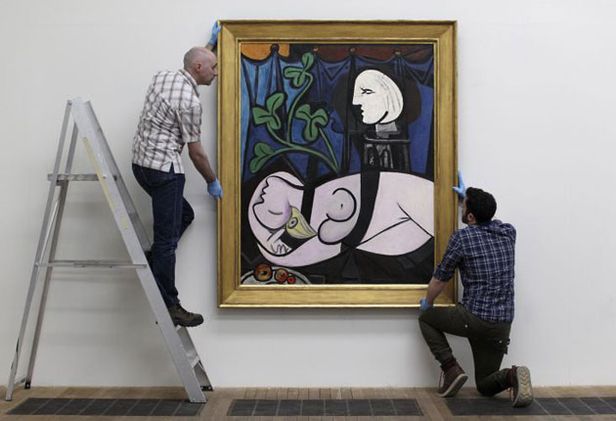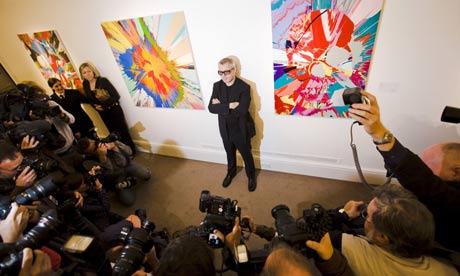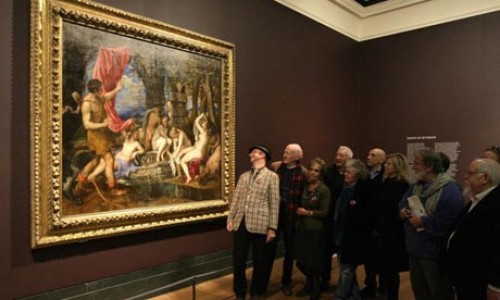
Picasso's "Nude, Green Leaves, and Bust" (1932) at Tate Modern. Image Andy Paradise/PA.
Funny how very expensive paintings become metaphors of themselves. The 45-million-dollar Duccio bought by the Met in 2005 shows the incarnate deity supported with infinite care by his reverentially gazing mother, in prophecy of the object’s later veneration by acquisitive museum trustees. Similarly, Raphael’s Madonna of the Pinks, picked up by the National Gallery in 2004 for a mere 35 million pounds, predicts its own historical afterlife as object of enraptured awe: the Madonna both supports and frames the child, holding it and owning it. Actaeon unveils the nude Diana at her bath, like a museum director pulling a curtain cord at a press conference, in a Titian bought by the National Gallery for roughly the GDP of Belgium in 2008. In all of these works, the looked-upon object of attention is, like a work of art, something between divine and physical, capable of redeeming (Christ) or cursing (Diana) the life of the observer. It’s all in the viewer’s use of what he or she beholds. Look how, in Duccio’s painting, Christ returns the touch, or how Diana’s body, the whole shebang, is stretched out for Actaeon’s grateful view. These paintings dramatize rapture at the sight of a beautiful thing.
It’s remarkable how often these performances of revealed beauty take center stage in major museum acquisitions of works of art. (Because we’re worth it, they seem to say, justifying themselves to a skeptical public.) Once an artwork is sold, it is changed permanently. The purchase itself seems part of the painting’s meaning, its reason for being. Very expensive contemporary art does this too: big, shiny objects by Hirst, Koons, or Murakami are themselves performances of expensiveness, in which the painted observer (Mary, Actaeon) is substituted for the gaze of the valuer, auctioneer, purchaser. Rapture is implied.

Damien Hirst at his 2008 Sotheby's auction. Photograph: Felix Clay.
Something similar happens in another very expensive painting, now on long-term loan to Tate Modern from an ostensibly anonymous buyer whose identity everyone I know seems to know anyway. Picasso’s Nude, Green Leaves, and Bust (1932) sold for 100 million dollars at auction last year. It’s a picture of two horizontal halves: one, a studio setting, with a draped screen, sculpted bust of a classical column, and four curving tendrils of a green plant, and the other a nude woman not so much reclining as unfurling, her head tipped back, breasts akimbo. Shadows from the bust curl around the body like straps supporting a large-scale sculpture: she’s being lowered into place. The two profiles (bust and woman) act as reflections of each other, an interplay of representations that, by 1932, was Picasso’s principal party trick. Yet unlike other more or less contemporary works by Picasso hung alongside the painting at the Tate, it’s difficult, perhaps impossible, to shuttle the work away by bringing up the old chestnut of biography (Picasso’s twin muse and curse). The price gets in the way. You start looking at it like a potential purchaser checking out a used car in a lot, looking for kinks, letting your understanding of the price be your compass. That smudge of paint by her left nipple: can’t we knock off a million for that? And how about those disappointingly squidgy apples? It is, now and for as long as it exists, impossible to see the painting for the fog of its cost.
Picasso’s painting, like Duccio’s, Raphael’s and Titian’s, appears to preempt this, though. As with more or less all of Picasso’s work post-1906, the beholder remakes the beheld according to the lineaments of lust. So the swooping curves of the model’s body (the artist’s then-girlfriend, Marie-Therese Walter) is picked up in the tendrils of the plant. The V of her genitals becomes a Mexican wave of sexual infatuation, zigzagging across the hanging screen and fracturing the blue. The shadow of the bust (unmistakeably, and characteristically, the artist’s own), presses his lips to the cleft curves of the plant’s leaves in anticipation of a bit of afternoon delight. The work thrums with erotic excitement and by doing so, stages its own value as an object. There is eroticism to the acquisition of beautiful objects; here, that erotic charge anticipates itself. Picasso’s delight in beholding the beautiful thing is so powerful that it bends the world.
Academics hate billionaire art collectors because they think they don’t get it. When Steve Wynn, the casino owner, accidentally knocked a hole in his Picasso while showing some pals around his office, the stench of art world schadenfreude was overwhelming. When Abramovic or Pinault or Megrabi (“the man with 800 Warhols”) drop a few million on a famous work of art for no apparent academic or intellectual reason — or without necessarily knowing that much about the artist or the work — the upper eschelons of academic art history are quick to detach themselves, claiming they “hate the art world” and its venality (everyone, at some point, says that). However, if we’re honest, we know that works like Picasso’s, Titian’s, Raphael’s, and Duccio’s — perhaps even Hirst’s, Koons’s and Murakami’s, and a great deal more works besides — are predicated on an erotic, not an intellectual, transaction. More power to Steve Wynn’s elbow.






Pingback: criticismism » Blog Archive » Found Objects 03/04/11